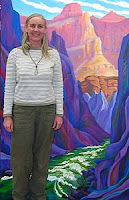
Serena Supplee
As I left the sprawling metropolis of Salt Lake City late last week, I decided to check my messages before entering the no-man’s land of cell signals. Having punched the correct sequence of numbers into the telephone, I was treated to the slightly smoky voice of Serena Supplee spilling out of the handset. Serena informed me that Terry Tempest Williams, noted Southwest writer, was doing a reading in Moab, and suggested I attend. Serena, Barry and I have been talking with Terry about the history of Twin Rocks Modern weavings and Serena felt I should check in.
By the time I retrieved the message, it was late in the afternoon and I still had to swing by Home Depot to buy paint for Grange’s newly constructed bat house. With a little luck from the freeway Gods I might make it on time. Traffic is an unknown commodity in Bluff, so I am not competent when it comes to predicting metropolitan travel times. Fortune smiled on me that afternoon, however, so I managed to avoid the crush of homeward bound commuters.
When I arrived at Star Hall in Moab, the reading had already commenced, so I quietly took a seat near the back of the auditorium and settled in for stories about Rwanda, prairie dogs and the influence of art on our daily lives.
During her presentation, Terry blended unbelievable tragedy with extraordinary hope, courage and forgiveness. Art, it seems, was the glue that helped bridge the gulf between the pain of ethnic and environmental cleansing and compassion. Mosaic was the metaphor for her experiences. As Terry pointed out, art is a universal language.

Navajo Zig Zag Twin Rocks Modern Rug by Eleanor Yazzie
During her concluding remarks, Terry said, “Art is the spark.” The comment reminded me of a conversation I had with Bruce Hucko, well-known photographer and art coach to the children of southeastern Utah. Bruce has spent decades encouraging artistic creativity among the youth of the Colorado Plateau, with stunning results. His children’s book A Rainbow at Night is one of my favorites.
During a discussion about Navajo folk artist Charlie Willeto, Bruce had recently said, “You have to create the environment.” He was referring specifically to Jim Mauzy, trader from Mauzy’s Trading Post at Lybrook, New Mexico, and others who recognize that the Indian trader’s fundamental role is to build and nurture an environment where people freely express themselves.
When no one else would, Mauzy supported Charlie; buying his work for a sack of flour or a bag of canned goods, even though Mauzy had no idea what to do with the carvings. Surely Mauzy could not begin to conceive that Charlie’s sculpture would come to be known internationally, or that he would be mentioned in connection with twentieth-century self-taught luminaries like William Edmondson, Bill Traylor and Martin Ramirez.

Navajo Coyote Skinwalker by Robin Wellito
As Bruce pointed out, it is all about building an environment that sets the creative landslide in motion. It is, however, often difficult to know which rock to dislodge to start the tumult. Barry and I have done things we were sure would result in striking success, only to find we could not be more wrong. On the other hand, we have seen movements result in beautiful rugs, baskets, folk art or jewelry when we thought they were doomed to failure.
Maybe creating the right environment is a little like chemistry lab when I was in school; under the right conditions, one strike was all it took to ignite Mr. Guymon’s classroom. Surely art is the spark, but a little combustible material never hurts. Barry and I keep looking for just the right mixture.
With Warm Regards,
Steve, Barry and the Team.
Copyright 2008 Twin Rocks Trading Post

No comments:
Post a Comment